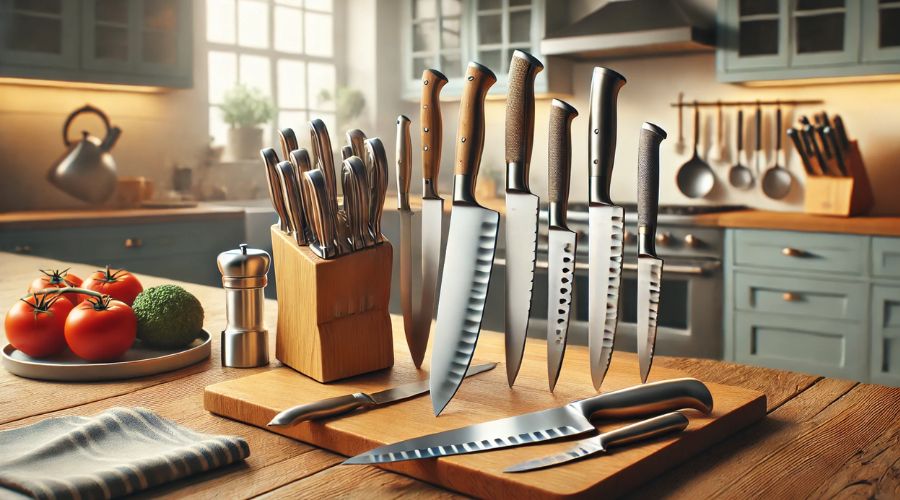Why Bread Knives Are Safer and More Efficient for Bread Slicing
When it comes to slicing bread, especially artisan loaves with thick crusts or fluffy, airy centers, using the right knife makes all the difference. Bread knives, designed specifically for cutting bread, are safer and more efficient than standard knives for several key reasons. These knives typically have a long, serrated blade that enables precise cuts, preserves the bread’s texture, and minimizes the risk of accidents. Let’s explore why bread knives are essential in any kitchen and how they make bread slicing safer and more effective.
Bread knives are indispensable in any kitchen for their ability to safely and effectively slice bread without crushing or tearing. They’re designed with a serrated edge that reduces the effort needed to cut through crusts and provides greater control, enhancing both safety and efficiency. Whether you’re a professional knife store or a home cook, a good bread knife can elevate your kitchen experience, making it a must-have for anyone who values quality, safety, and precision.
Unique Design of Bread Knives
Bread knives are specifically crafted with a serrated blade, designed to handle the unique texture of bread. Serrations work by creating small points of pressure, which helps cut through the crust and inner crumb without excessive downward force. The typical length of a bread knife ranges from 8 to 12 inches, providing enough reach to cut through even large loaves in one smooth motion.
The blade of bread knife design is perfect for bread: it grips the crust with each sawing motion, reducing slippage and ensuring the cut stays on course. Traditional kitchen knives, on the other hand, often compress and tear bread instead of slicing cleanly through it.
Serrated Blades Minimize Crushing
A straight-edged knife, while sharp, requires considerable downward pressure to penetrate a loaf of bread. This pressure can quickly crush the bread, especially softer, airy varieties. A bread knife’s serrated blade, however, cuts cleanly through both hard crusts and delicate interiors without squashing or compressing the loaf.
The saw-like motion of a bread knife distributes pressure more evenly along the loaf’s surface, allowing the blade to penetrate without pressing down. This minimizes both mess and waste, preserving the shape and texture of each slice.
Bread Knives Improve Safety with More Control
When slicing bread with a chef’s knife or any straight-edged blade, you’re more likely to apply extra force, making the knife more difficult to control. This force can increase the risk of slipping, especially when trying to cut through a crusty loaf. Bread knives, with their serrated edges, don’t require as much downward force, enabling better control.
A safer cut is achieved through the sawing motion of a bread knife, which uses less force and reduces the risk of the blade slipping off the bread and injuring your hand. This increased control makes bread knives an ideal tool for people of all skill levels, from beginner cooks to professional chefs.
A Cleaner Cut for Presentation
Presentation matters, whether you’re serving a meal at a restaurant or preparing a family brunch. Bread knives allow for clean, even cuts that showcase the loaf’s internal crumb structure and crust, making each slice visually appealing. A straight knife, on the other hand, may compress the slice and cause tearing, resulting in an uneven and less attractive presentation.
The clean slice achieved with a bread knife is especially important when dealing with delicate pastries or cakes with layered fillings. A sharp, serrated edge maintains the structure and integrity of these baked goods, preserving their appearance and making them easier to serve.
Reduced Effort and Fatigue
Trying to slice a dense loaf with a regular knife can be exhausting. Bread knives are designed to make slicing easy, requiring minimal pressure to achieve an effective cut. This ease of use is especially beneficial when slicing multiple loaves or larger, denser breads that would otherwise require considerable effort.
The serrated edge of a bread knife lets the blade do the work, allowing you to maintain control and reducing fatigue on your wrist and hand. This makes bread knives an invaluable tool for bakers and home cooks alike, who often need to slice through many loaves in one sitting.
Versatility Beyond Bread
While bread knives are optimized for cutting bread, their usefulness extends beyond loaves. They are also great for slicing foods with tough exteriors and soft interiors, such as tomatoes, citrus fruits, and melons. The serrated edge handles these textures well, offering smooth cuts without mashing the fruit.
Additionally, bread knives are ideal for slicing cakes and pastries. When cutting a delicate sponge or layered cake, a bread knife’s serrated blade ensures that the cake maintains its shape without crumbling or tearing. This versatility makes the bread knife one of the most multifunctional tools in a kitchen.
Longer Lifespan and Sharpness Retention
Bread knives maintain their sharpness longer than straight-edged knives because they don’t require frequent sharpening. Serrated blades are naturally durable and hold up well over time, even with regular use. The points of the serrations take the brunt of the cutting force, protecting the recessed parts of the blade from dulling as quickly as a flat blade would.
When it is time to sharpen a bread knife, it requires a special sharpening tool. However, since bread knives stay sharp for longer, they rarely need frequent sharpening, making them a low-maintenance addition to the kitchen.
Prevents Waste by Reducing Crumbs
Bread knives are designed to minimize crumbs, preserving as much of the loaf as possible. When you use a straight-edged knife on bread, the excess pressure causes crumbling, leaving crumbs all over your cutting board. This not only creates mess but also wastes part of the bread.
A bread knife’s serrated edge significantly reduces crumbling, allowing for cleaner cuts and less mess. The sawing motion distributes pressure evenly, preventing the loaf from crumbling excessively and ensuring that each slice is as intact as possible.
Essential for Artisanal and Specialty Breads
With the rise of artisanal and specialty breads—such as sourdough, ciabatta, and baguettes—a bread knife has become an essential tool. These types of bread typically have hard, crusty exteriors that can be challenging to cut with a standard knife. A bread knife’s serrated edge is well-suited for these breads, enabling smooth and precise cuts without damaging the delicate, airy interior.
Artisan bread often relies on its texture for flavor, and a bread knife ensures you’re not crushing or compacting it, allowing you to experience the bread as it was meant to be enjoyed.
Investment in Kitchen Safety and Efficiency
Bread knives are more than just tools for cutting bread; they are an investment in safety, efficiency, and quality. With their unique design, these knives provide safer handling, superior control, and less mess. The value of a bread knife goes beyond functionality, as it allows for a better dining experience, preserving the texture and appearance of each loaf.
From minimizing crumbs to handling various foods beyond bread, a high-quality bread knife is a versatile and essential tool in any kitchen. Its durability and efficiency make it an investment worth making, adding value and practicality to daily cooking tasks.






